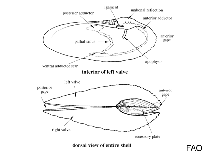Penitella penita (Conrad, 1837)
Flap-tip piddock| Native range | All suitable habitat | Point map | Year 2050 |

|
| This map was computer-generated and has not yet been reviewed. |
| Penitella penita AquaMaps Data sources: GBIF OBIS |
Google image | No image available for this species;
drawing shows typical species in Pholadidae.
Classification / Names Common names | Synonyms | CoL | ITIS | WoRMS
Bivalvia | Myida | Pholadidae
Environment: milieu / climate zone / depth range / distribution range Ecology
Benthic; depth range 0 - 22 m (Ref. 95344). Temperate
Distribution Countries | FAO areas | Ecosystems | Occurrences | Introductions
Eastern Pacific.
Length at first maturity / Size / Weight / Age
Maturity: Lm ? range ? - ? cm Max length : 7.2 cm SHL male/unsexed; (Ref. 95344); max. reported age: 21 years (Ref. 8702)
Life cycle and mating behavior Maturity | Reproduction | Spawning | Eggs | Fecundity | Larvae
Main reference
References | Coordinator | Collaborators
Bisby, F.A., M.A. Ruggiero, K.L. Wilson, M. Cachuela-Palacio, S.W. Kimani, Y.R. Roskov, A. Soulier-Perkins and J. van Hertum. 2005. (Ref. 19)
IUCN Red List Status
(Ref. 130435: Version 2024-2)
CITES status (Ref. 108899)
CMS (Ref. 116361)
Threat to humans
Human uses
| FishSource |
Tools
More information
Diet composition
Food consumption
Predators
Max. ages / sizes
Length-weight rel.
Length-length rel.
Length-frequencies
Mass conversion
Abundance
Internet sources
BHL | BOLD Systems | CISTI | DiscoverLife | FAO(Publication : search) | Fishipedia | GenBank (genome, nucleotide) | GloBI | Gomexsi | Google Books | Google Scholar | Google | PubMed | Tree of Life | Wikipedia (Go, Search) | Zoological Record



